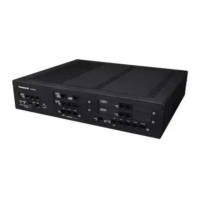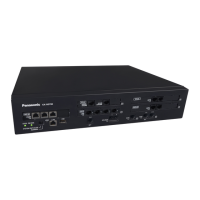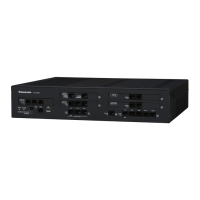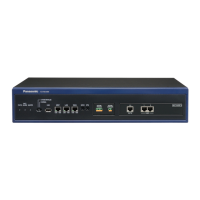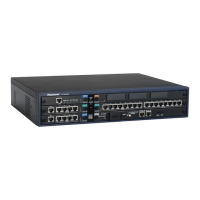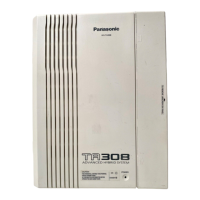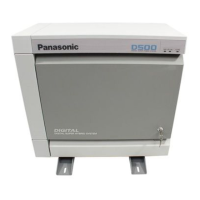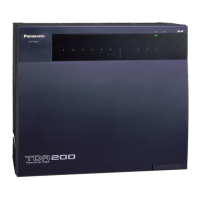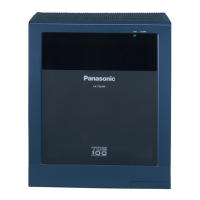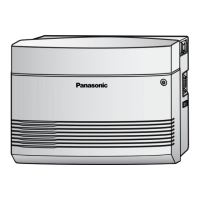2.28.3 Voice Mail DPT (Digital) Integration
Description
A Panasonic
VPS that supports DPT (Digital) Integration (e.g., the KX-TVM200) can be connected to this PBX
in a tightly integrated fashion.
DPT (Digital) Integration features can be used when the VPS is connected through DPT ports of the PBX.
Feature Explanation
1. Automatic Configuration—Quick Setup
The PBX informs the VPS of its extension numbers and the floating extension numbers of the incoming
call distribution groups so that the VPS can create mailboxes with this data automatically.
2. FWD to a Mailbox of the VPS
If an extension user sets FWD to the VPS, incoming calls are forwarded to the VPS. (® 2.3.2 Call
Forwarding (FWD)) The PBX sends a mailbox number of the forwarding extension to the VPS.
Therefore the caller can leave a message in the mailbox of the extension without knowing the mailbox
number.
3. Intercept Routing to a Mailbox of the VPS
If an extension user sets Intercept Routing to the VPS, the intercepted trunk calls will be redirected to the
VPS. (® 2.1.1.6 Intercept Routing) If the "Intercept to Mailbox for Call to Extension" setting
is enabled through system programming, the PBX sends the mailbox number of the intercepted extension
to the VPS.
If the VPS is set as the overflow destination of an Incoming Call Distribution (ICD) Group and the
"Overflow to Mailbox for Call to ICD Group" setting is enabled through system programming,
the PBX sends the mailbox number of the ICD group to the VPS.
Therefore the caller can leave a message in the appropriate mailbox without knowing the mailbox number.
If either of these settings is disabled, calls of the corresponding type are handled by the Trunk Service
(e.g., Automated Attendant) in the VPS.
→ 11.11.1 PBX Configuration—[3-11-1] Group—VM(DPT) Group—System Settings—
Intercept to
Mailbox for Call to Extension
→ 11.11.1 PBX Configuration
—[3-11-1] Group—VM(DPT) Group—System Settings—
Overflow to
Mailbox for Call to ICD Group
4. Voice Mail (VM) Transfer Button
An
extension user can transfer a call to a mailbox of an extension by pressing the VM Transfer button and
entering the number of the extension. The transferred caller can then leave a message in the mailbox. The
VM Transfer button can also be used by extension users at other times, as follows:
a. By pressing the VM Transfer button when the extension is idle, the extension's mailbox is called and
Voice Mail messages can be listened to. This feature can be used even if the Message Waiting lamp
is not on.
b. Pressing the VM Transfer button while a call is incoming will redirect the call to the called extension's
mailbox. This is useful when the called extension user does not want to answer the call.
c. If you call an extension, and the other party does not answer, pressing the VM Transfer button will
transfer your call to the called extension's mailbox so that you can leave a message. This feature can
also be used when the called extension is busy or set to DND.
5. Transfer Recall to a Mailbox of the VPS
If a call is transferred to an extension via the Automated Attendant (AA) service of the VPS and the call is
not answered within a preprogrammed Transfer Recall time, the PBX sends the mailbox number of the
transfer destination extension to the VPS. Therefore the caller can leave a message in the mailbox of the
extension without knowing the mailbox number. The "Transfer Recall to Mailbox" setting should
be enabled through system programming to use this feature.
® 10.3 PBX Configuration—[2-3] System—Timers & Counters—Dial / IRNA / Recall / Tone—
Recall—Transfer Recall (s)
®
11.11.1 PBX Configuration—[3-11-1] Group—VM(DPT) Group—System Settings—
Transfer Recall
to Mailbox
Feature Guide 311
2.28.3 Voice Mail DPT (Digital) Integration
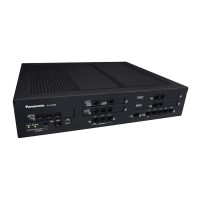
